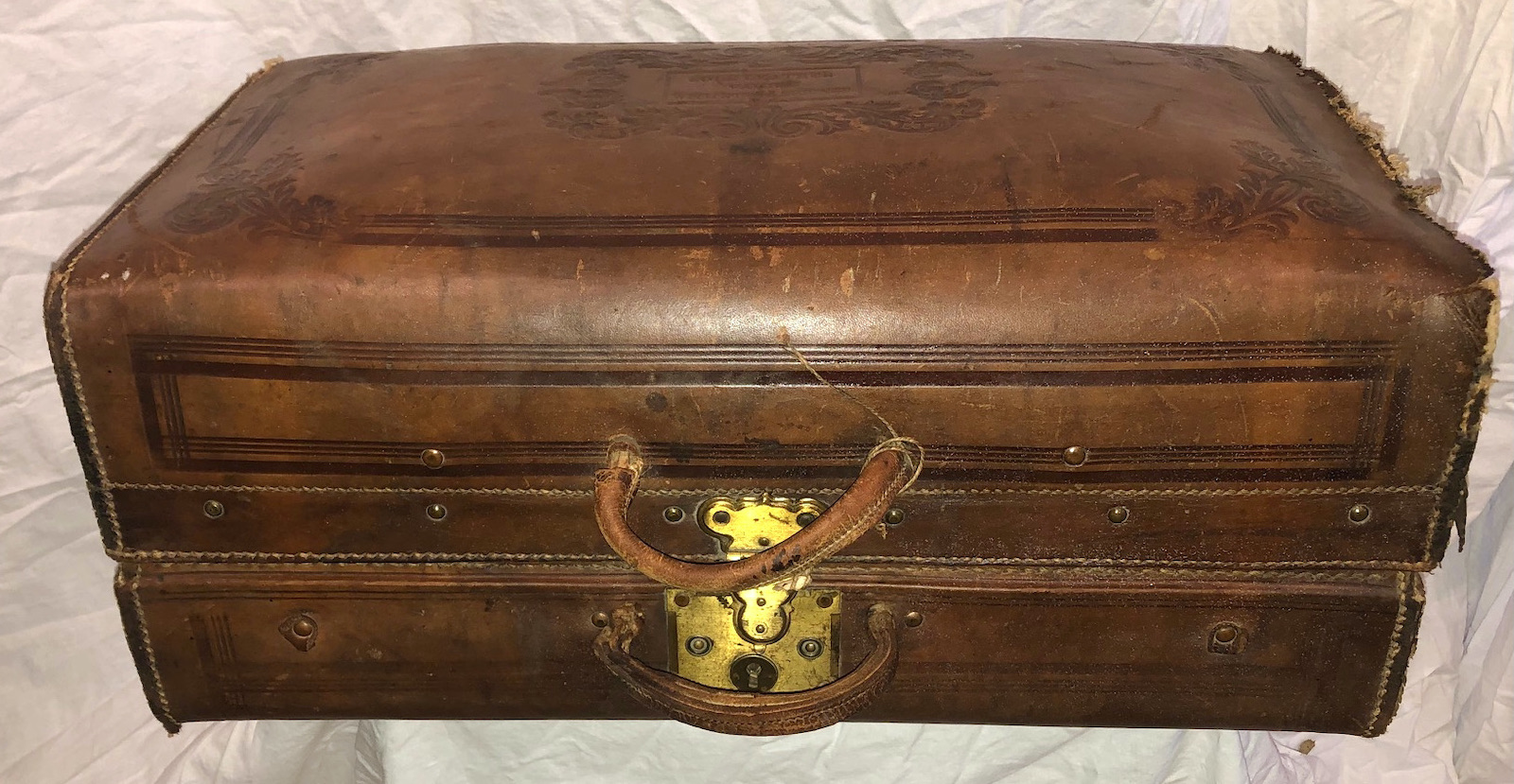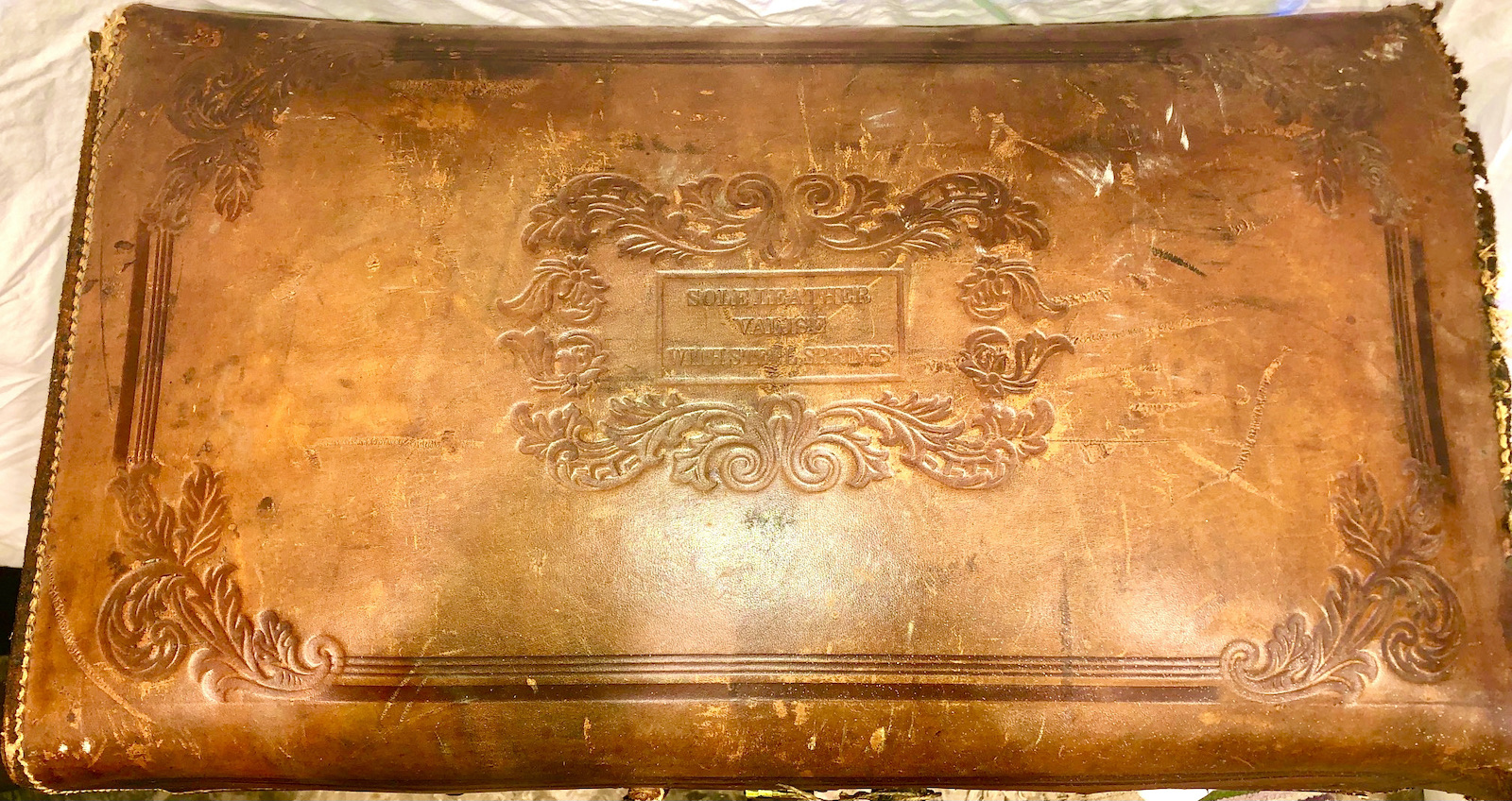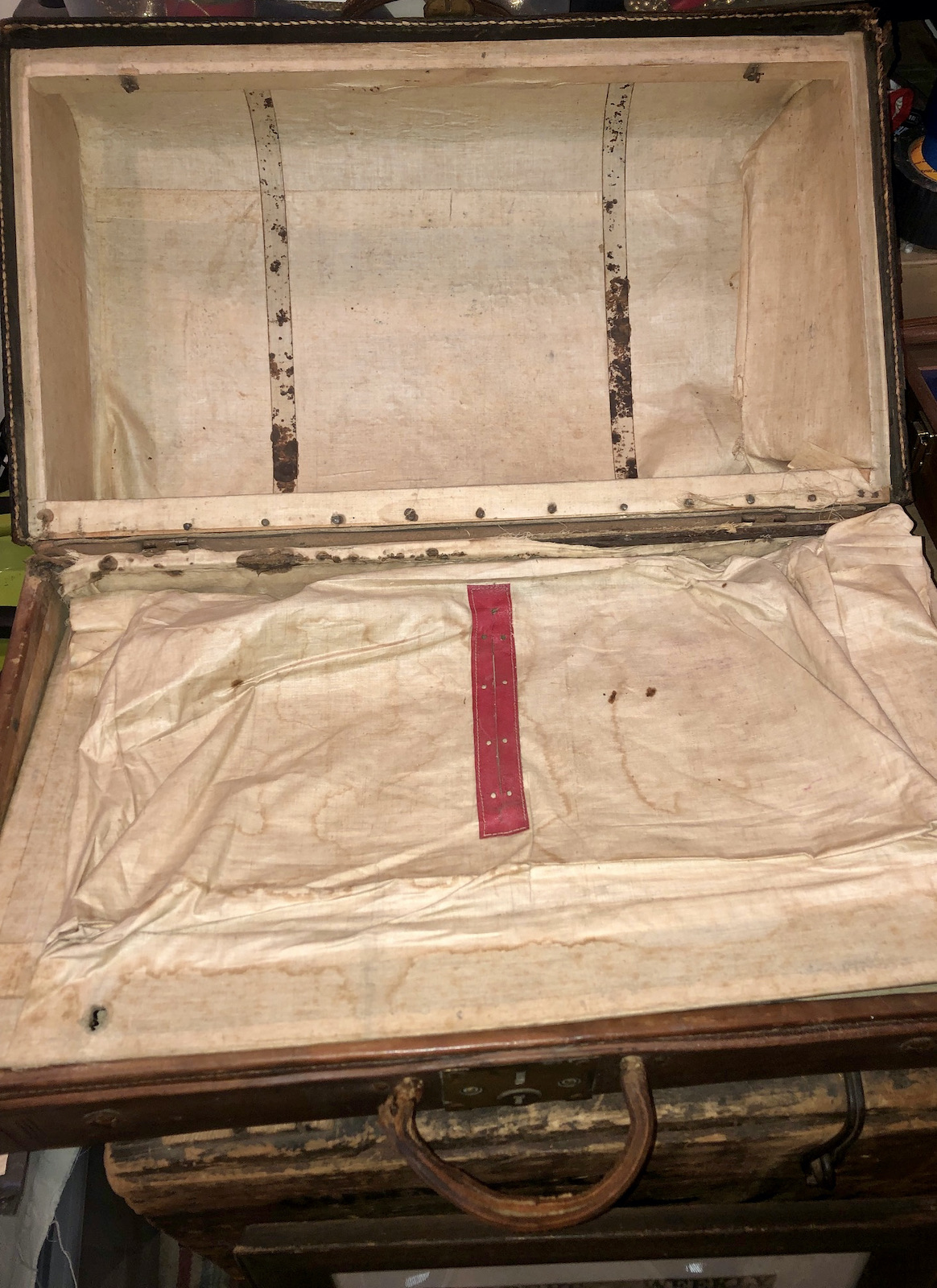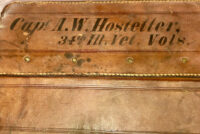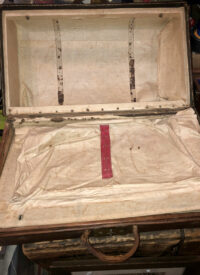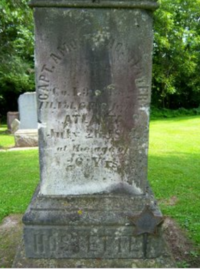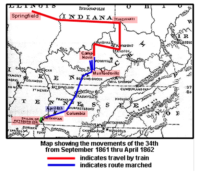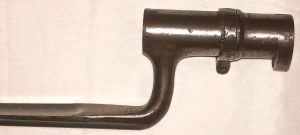Finely Crafted Id’d Civil War Officer’s Valise – Capt. Amos Hostetter,34th Illinois Infantry – Mortally Wounded at the Battle of Kennesaw Mountain
SOLD
Finely Crafted Id’d Civil War Officer’s Valise – Capt. Amos Hostetter,34th Illinois Infantry – Mortally Wounded at the Battle of Kennesaw Mountain – This fine, high quality, brown leather valise has the following stenciled, in large letters, in black ink, on the left end of the valise:
“Capt. A.W. Hostetter,
34th Ill. Vet. Vols.”
Hostetter, a 24 year old clerk, enlisted into Co. I of the 34th Illinois Infantry, in August of 1861, as a 1st Lieutenant; he would be promoted to the rank of Captain, in April of 1862. Hostetter was severely wounded, at the Battle of Kennesaw Mountain, Georgia, on June 27, 1864 and subsequently succumbed, one month later, on July 26, 1864. Capt. Hostetter and his regiment would see considerable action during his tenure with the 34th Illinois – Corinth, Shiloh, Stones River, Resaca, Rome, the onset of the Atlanta Campaign and Kennesaw Mountain.
The valise is constructed of a high grade, russet brown leather, as indicated by the embossing on the top that reads:
“SOLE LEATHER
VALISE
WITH STEEL SPRINGS”
The 19th century term “SOLE LEATHER” was indicative of a higher quality leather, utilized in the construction of an item. This valise, at the time of its original use, would have been the veritable top of the line – besides the decorative, embossed leather covering, it exhibits small copper, decorative tacks, on the exterior; an impressive, large brass locking mechanism; an interior lined in a fine linen; an interior, gold embossed, green leather document pouch; a two tiered, compartment interior, one closed via brass hooks. Within the valise remains two original, long closure straps – one leather and one heavy cotton; another interior closure, leather covered bar with linen straps and period adjustment clasps; this valise was constructed for the well-to-do traveler.
Condition: The valise remains in overall good, stable condition; the exterior does have some seam openings, and the carrying handles are worn, with some weakness where they connect to the body of the valise. The interior exhibits some tears in the linen lining, but mostly remains intact; this all could be readily restored.
Measurements: Width across – 24”; Width front to back – 14”; Height or Depth – 9.5”
We have had several officers’ trunks, large and small, but this valise is a rather unique piece of war period, officer’s traveling equipment, identified to an infantry officer veteran who was mortally wounded during the Atlanta Campaign.
Amos B. Hostetter
| Residence was not listed; 24 years old.
Enlisted on 8/15/1861 at Camp Butler, Springfield, IL as a 1st Lieutenant. On 9/7/1861 he was commissioned into “I” Co. IL 34th Infantry He died of wounds on 7/26/1864 He was listed as: * Wounded 6/27/1864 Kennesaw Mountain, GA Promotions: * Capt 4/18/1862 He was described at enlistment as: 5′ 11.7″, dark complexion, gray eyes, brown hair Other Information: born in Lancaster County, PA |
34th IL Infantry
( 3-years )
| Organized: Camp Butler, Springfield, IL on 9/7/61 Mustered Out: 7/12/65 at Louisville, KYOfficers Killed or Mortally Wounded: 11 Officers Died of Disease, Accidents, etc.: 2 Enlisted Men Killed or Mortally Wounded: 129 Enlisted Men Died of Disease, Accidents, etc.: 119 (Source: Fox, Regimental Losses) |
| From | To | Brigade | Division | Corps | Army | Comment |
| Oct ’61 | Nov ’61 | Johnson’s 3rd | McCook’s Command at Nolin | Army of Ohio | ||
| Nov ’61 | Dec ’61 | 5 | Army of Ohio | |||
| Dec ’61 | Sep ’62 | 5 | 2 | Army of Ohio | ||
| Sep ’62 | Nov ’62 | 5 | 2 | 1 | Army of Ohio | |
| Nov ’62 | Jan ’63 | 2 | 2 | Right Wing, 14 | Army of Cumberland | |
| Jan ’63 | Oct ’63 | 2 | 2 | 20 | Dept and Army of Ohio and Cumberland | |
| Oct ’63 | Nov ’63 | Coburn’s | Dept and Army of Ohio and Cumberland | |||
| Nov ’63 | Jul ’65 | 2 | 2 | 14 | Dept and Army of Ohio and Cumberland | Mustered Out |
| Jan ’64 | Mar ’64 | 2 | 4 | 13 | Army and Dept of the Gulf |
Courtesy of The Horse Soldier, Gettysburg, Pa.:
Amos W. Hostetter was born in Lancaster County, Pennsylvania in 1838.
In 1860 he was living with his uncle in Carroll County, Illinois and working as a bank clerk. On August 15, 1861 he was commissioned a 1st lieutenant in Company I, 34th Illinois Infantry. Before leaving home for the front Hostetter was married to Miss Elizabeth Shirk.
Hostetter saw his first action at Shiloh and on the 18th of April he was made captain of his Company. He led his men through Corinth, Stones River, Rocky Face Ridge, Resaca, Rome, Dallas and Kennesaw Mountain. In the advance on Atlanta Captain Hostetter was wounded along the skirmish line and died on July 26, 1864.
In his official report on the Atlanta Campaign the commanding officer of the 34th Illinois, Lt. Col. Oscar Van Tassell said “…taking an honorable part in the siege of Atlanta, in which we lost Capt. Amos W. Hostetter, an officer than whom a braver or more trustworthy never drew sword in the defense of the right, who was never absent from his command or duty for more than forty-eight hours at a time during all his term of service, leaving a record behind him of which any officer or man might well be proud…”
It is said that when his body was brought home and buried in Mount Carroll Cemetery, Hostetter’s Newfoundland dog laid on his grave and remained until he too, died.
Illinois
THIRTY-FOURTH INFANTRY.
(Three years )
| The Thirty-fourth Infantry Illinois Volunteers was
organized at Camp Butler, Illinois, September 7, 1861, by Colonel E. N. Kirk. Moved, October 2, to Lexington, Kentucky, and from thence to Louisville and thence to Camp Nevin, Kentucky, where it remained until February 14, 1862. Marched to Bowling Green, and thence, via Nashville, Franklin and Columbia, to Savannah, on the Tennessee River. Arrived at Pittsburg Landing, April 7,1862, and was hotly engaged in that battle, losing Major Levanway and 15 men killed, and 112 wounded. From thence moved to Corinth, and was engaged on the 29th May, losing one man killed and five wounded. From Corinth moved to Iuka and Florence, Alabama. Crossed the river at that place and moved to Athens, Huntsville and Stevenson, Alabama. Was encamped over a month at Battle Creek. From thence marched, via Pelham, Murfreesboro and Nashville, to Louisville, Kentucky, arriving September 27, 1862. Brigade commanded by Colonel F. M. Stambaugh, Seventy-seventh Pennsylvania Volunteers, General McCook commanding the Division.
October 1, 1862, left Louisville for Frankfort. Regiment commanded by Lieutenant Colonel H. W. Bristol, Brigade by Colonel E. N. Kirk, and Division by Brigadier General Still. October 4, was engaged in a skirmish at Clayville, Kentucky. From Frankfort, moved, via Laurensburg, Perryville, Danville, Crab Orchard, Lebanon and Bowling Green, to Nashville. November 27, had a skirmish at Lavergne. Regiment remained in camp five miles southeast of Nashville until December 26, 1862. Second Brigade, Brigadier General E. N. Kirk commanding; Second Division, Brigadier General Pt. W. Johnson commanding. Right Wing of Fourteenth Army Corps, Major General Alexander McD. McCook commanding.
December 27, Right Wing moved toward Triune, the Thirty- fourth in advance, encountered the enemy commanding the approaches to Triune; drove him till noon, when he formed in the town. The nature of the ground preventing the use of the artillery, the infantry was advanced, and after a sharp fight, drove the enemy from the town–the enemy taking his artillery with him. 29th, moved via Independence Hill, toward Murfreesboro. 30th, took position as extreme right of Union lines. 31st, the enemy attacked the Regiment in overwhelming force, driving it back on the main line. Following the advantage gained by his infantry, the enemy’s cavalry charged the line, and captured many of the Regiment. Loss–killed 21, wounded 93, missing 66. General Kirk was mortally wounded. During the three following days, the Thirty-fourth did guard duty.
While at Murfreesboro, the Right Wing, Fourteenth Army Corps, was organized into the Twentieth Army Corps, and Major General McCook assigned to command.
June 24,1863 the Twentieth Corps moved by the Shelbyville pike, toward Liberty Gap. On the 25th, the Second Brigade was ordered forward, and advanced across an open cornfield, eighty rods in width, lately plowed and softened by the rains which fell the day and night before, until the men sunk half way to the knee in mud at every step. Without help, and in the face of a rebel Brigade advantageously posted, they drove the enemy from his position–the Second Arkansas infantry leaving their battle flag on the bill, where they fought in front of the Thirty- fourth. The Regiment losing 3 killed and 26 wounded.
Moved, on 26th, via Beech Grove, to Manchester, entering Tullahoma on the morning of July 1.
August 7, Colonel A. P. Dysart resigned, leaving the Regiment under command of Lieutenant Colonel Oscar Van Tassell.
August 16, moved via Larkin’s Valley, to BelleFonte, Alabama. The Thirty fourth was here detailed as Provost Guard. 30th, moved to Caperton’s Ferry, on Tennessee River. Here the Regiment was left to guard the pontoon bridge.
September 18, moved the boats to Battle Creek.
October 20, 1863, moved, under command of Brigadier General J. D. Morgan, to Anderson’s Cross Roads, in Sequatchie Valley.
November 8, moved to Harrison’s Landing, on Tennessee River. November 14, ordered to report to Brigadier General John Beatty, commanding Second Brigade, Second Division, Fourteenth Army Corps, Jeff. C. Davis commanding Division. Arrived at Chattanooga 15th, and camped on Moccasin Point.
November 28, ordered to join the Brigade on the battle field of Chattanooga. Arrived 11 o’clock P. M. Moved at 1 o’clock A. M. of the 26th, via Chickamauga Station–met the retreating enemy near Graysville, and was engaged about half an hour.
November 28, moved back to Chattanooga, where those unable to march were put in camp. The remainder of the Regiment moved on the expedition into East Tennessee as far as London, where the Thirty-fourth was detained to run a grist mill, grinding corn and wheat for the Division. Returned to Chattanooga, arriving December 19,1863.
December 22, the Thirty-fourth was mustered as a veteran organization, and January 8, 1864, started for Springfield, Illinois, for veteran furlough.
Received veteran furlough and rendezvoused at Dixon, Illinois. February 28, moved via Chicago, Louisville and Nashville, arriving at Chattanooga March 7, 1864, and moved out to join the Second Brigade, Colonel John G. Mitchell, One Hundred and Thirteenth Ohio, commanding, in camp near Roseville, Georgia.
Went into camp at Roseville, Ga., March 7, 1864. Assigned to Second Brigade, Second Division, Fourteenth Army Corps. Left Roseville May 5, for Ringgold, arriving same day. May 9, took a prominent part in the engagement at Rocky Face Ridge, in which the Regiment had one man killed and ten men wounded.
May 14, charged the enemy at Resaca, Ga., crossing an open field in the face of a furious fire of cannister from a battery at close range; drove the enemy from the hill and held it until night. Loss fifty men killed and wounded. May 17, in engagement at Rome, Ga., had eight men wounded.
Left Rome May 24, passed through Dallas, Ga., May 26. After skirmishing almost every day arrived at Big Shanty where on June 15, the Regiment charged the enemy who were behind barricades of railroad ties, capturing the works and taking more prisoners than the Thirty-fourth Infantry had men in line. Loss one man killed and seven wounded.
On June 27 1864, led the Brigade in the charge on Kenesaw Mountain. After reaching the top of the rebel works, overwhelming numbers compelled them to fall back leaving some of their dead on the enemy’s works. In this battle the Regiment had five killed and forty wounded. July 3, pursued the enemy through Marietta, Ga., and on to Atlanta; took a prominent part in the sedge of Atlanta, being engaged almost every day in skirmishes of greater or less note, having men killed and wounded almost daily.
September 4, 1864, led the Brigade and Division in the charge on the enemy’s works at Jonesboro, Ga., being the first soldiers in the rebel fort taking artillery captured from the Army of Tennessee on July 22, 1864, together with a number of prisoners. The regiment had about sixty men killed and wounded.
September 29, left Atlanta with Second Division, Fourteenth Army Corps for the purpose of driving Forrest from Tennessee; pursued him to Florence, Alabama, driving him across the Tennessee River, after which the Regiment rejoined Sherman’s Army south of Chattanooga in Northern Alabama. Returned with army to Atlanta and went with Sherman to the Sea, and on the Campaign through the Carolinas. In a light engagement at Averysboro, N. C., on March 16,1865, had three men killed and five wounded.
March 19, 1865, took part in the battle of Bentonville, N. C., in which the Regiment was attacked from both the front and rear but stubbornly held the ground and repulsed the enemy. Loss eight killed and twenty-two wounded.
After lying at Goldsboro, N. C., until April 10, left for Raleigh, N. C., reaching there on the 13th, and on the 14th started with the Fourteenth Army Corps for Cape Fear River to intercept General Jos. E. Johnston’s retreat. On the 15th, had one man killed and one wounded by rebel cavalry.
After the surrender of Johnston the Regiment went with Sherman’s Army to Washington, D. C., and took part in the grand review May 24, 1866.
Left Washington June 12. and arrived at Louisville, Ky., June 18, where the Regiment was mustered out on July 12, and was discharged and paid at Chicago, Ill., on July 17, 1865. |
| NAME: | Amos W Hostetter |
| RANK: | 1st Lieutenant |
| COMPANY: | I |
| UNIT: | 34th Illinois Infantry |
| HEIGHT: | 5′ 11 3/4 |
| HAIR: | BROWN |
| EYES: | GRAY |
| COMPLEXION: | DARK |
| MARITAL STATUS: | Married |
| OCCUPATION: | Clerk |
| BIRTH DATE: | Abt 1837 |
| BIRTH PLACE: | Salunga, Lancaster CO, PA |
| WAR: | Civil War |
| WAR YEARS: | 1861-1865 |
| SERVICE ENTRY AGE: | 24 |
| SERVICE ENTRY DATE: | 7 Sep 1861 |
| SERVICE ENTRY PLACE: | Camp Butler, IL |
| JOINED BY WHOM: | L HEFFELFINGER |
| PERIOD: | 3 YRS |
| MUSTER IN DATE: | 7 Sep 1861 |
| MUSTER IN PLACE: | Camp Butler, IL |
| REMARKS: | PROMOTED |
| RESIDENCE PLACE: | MT Carroll, Carroll CO, IL |
| NAME: | Amos W Hostetter |
| RANK: | Captain |
| COMPANY: | I |
| UNIT: | 34th Illinois Infantry |
| HEIGHT: | 5′ 11 3/4 |
| HAIR: | BROWN |
| EYES: | GRAY |
| COMPLEXION: | DARK |
| MARITAL STATUS: | Married |
| OCCUPATION: | Clerk |
| BIRTH DATE: | Abt 1838 |
| BIRTH PLACE: | Salunga, Lancaster CO, PA |
| WAR: | Civil War |
| WAR YEARS: | 1861-1865 |
| SERVICE ENTRY AGE: | 24 |
| SERVICE ENTRY DATE: | 31 May 1862 |
| SERVICE ENTRY PLACE: | Corinth, MS |
| JOINED BY WHOM: | GOV OF ILL |
| PERIOD: | 3 YRS |
| MUSTER IN DATE: | 11 May 1863 |
| MUSTER IN PLACE: | Murfreesboro, TN |
| REMARKS: | DIED OF WOUNDS JUL 26, 1864 |
| RESIDENCE PLACE: | MT Carroll, Carroll CO, IL |
A sorrowful homecoming for Capt. Hostetter, 34th IL Infantry, and his dog
One morning after the Battle of Atlanta, as he led a reconnaissance party, Capt. Amos W. Hostetter of Company I, 34th Illinois Infantry, was shot and mortally wounded by Confederate sharpshooters hidden in nearby woods. “The captain was held in high esteem by everyone with whom he came in contact,” the regimental historian recalled. Among those who loved the captain was his dog.
“The stretcher-bearers were sent for and brought him back, bearing him gently on their shoulders. As he reached the head of the regiment he began speaking to the men, bidding them farewell, and so continued on down the line through all of the companies which he passed. It was a pathetic scene. . . . He died the following day and his body was sent home. It is reported that his Newfoundland dog laid down on his grave and remained until it died.”
~ History of the Thirty-fourth Regiment of Illinois Volunteer Infantry. September 7, 1861 July 12, 1865,” by Edwin Waters Paine, published 1903.
Amos W. Hostetter to Owen P. Miles and Hannah Miles, Amos W. Hostetter Papers
34th Regiment, Illinois Infantry
OVERVIEW:
Organized at Camp Butler, Ill., and mustered in September 7, 1861. Moved to Lexington, Ky., October 2, 1861, thence to Louisville and Camp Nevin, Ky., and duty there till February, 1862. Attached to Johnson’s 3rd Brigade, McCook’s Command, at Nolin, Ky., to November, 1861. 5th Brigade, 2nd Division, 1st Corps, Army Ohio, to November, 1862. 2nd Brigade, 2nd Division, Right Wing, 14th Army Crops, Army of the Cumberland, to November, 1863. 2nd Brigade, 2nd Division, 14th Army Corps, Army of the Cumberland, to July, 1865.
SERVICE:
Advance on Bowling Green, Ky., and Nashville, Tenn., February 14-March 2, 1862. March to Savannah, Tenn., thence moved to Pittsburg Landing, Tenn., March 16-April 6. Battle of Shiloh, Tenn., April 6-7. Advance on and siege of Corinth, Miss., April 29-May 30. Pursuit to Bonneville May 31-June 6. Buell’s operations on line of Memphis and Tennessee R.R. in Northern Alabama and Middle Tennessee June to August. March to Nashville, Tenn., thence in pursuit of Bragg, to Louisville, Ky., August 21-September 26. Pursuit of Bragg into Kentucky October 1-16. Action at Floyd’s Fork October 1, near Clay Village October 4. Battle of Perryville October 8 (Reserve). March to Nashville, Tenn., October 16-November 7, and duty there till December 26. Reconnoissance toward Lavergne November 26-27. Lavergne, Scrougesville November 27. Advance on Murfreesborough December 26-30. Triune December 27-28. Battle of Stone’s River December 30-31, 1862, and January 1-3, 1863. Duty at Murfreesboro till June. Middle Tennessee or Tullahoma Campaign June 24-July 7. Liberty Gap June 24-27. Occupation of Middle Tennessee till August 16. Moved to Bellefonte, Ala., August 16, and detailed as Provost Guard. Moved to Caperton’s Ferry, Tennessee River, August 30, and guard pontoon bridge there till September 18. Moved boats to Battle Creek September 18. Moved to Anderson’s Cross Roads October 20, thence to Harrison’s Landing, Tennessee River, November 8. Joined Brigade at Chattanooga November 15. Battles of Chattanooga November 23-25; Tunnel Hill November 24-25; Missionary Ridge November 25; Chickamauga Station November 26. March to relief of Knoxville, Tenn., November 28-December 17. At Rissville, Ga., till May, 1864. Veterans on furlough January 8 to March 7, 1864. Atlanta (Ga.) Campaign May to September, 1864. Tunnel Hill May 6-7. Demonstration on Rocky Faced Ridge May 8-11. Buzzard’s Roost Gap May 8-9. Demonstration on Dalton May 9-13. Battle of Resaca May 14-15. Rome May 17-18. Operations on line of Pumpkin Vine Creek and battle about Dallas, New Hope Church and Allatoona Hills May 25-June 5. Operations about Marietta and against Kenesaw Mountain June 10-July 2; Pine Hill June 11-14; Lost Mountain June 15-17. Assault on Kenesaw June 27. Ruff’s Station, Smyrna Camp Ground, July 4. Chattahoochie River July 5-17. Peach Tree Creek July 19-20. Siege of Atlanta July 22-August 25. Flank movement on Jonesboro August 25-30. Battle of Jonesboro August 31-September 1. Lovejoy Station September 2-6. Pursuit of Forest and operations against Hood in North Georgia and North Alabama September 29-November 3. March to the sea November 15-December 10. Siege of Savannah December 10-21. Campaign of the Carolinas January to April, 1865. Averysboro, Taylor’s Hole Creek March 16. Bushy Swamp March 18. Battle of Bentonville March 19-21. Occupation of Goldsboro March 24. Advance on Raleigh April 14. Bennett’s House April 26. Surrender of Johnston and his army. March to Washington, D.C., via Richmond, Va., April 29-May 19. Grand Review May 24. Moved to Louisville, Ky., June 12. Mustered out July 12 and discharged at Chicago, Ill., July 17, 1865.
Regiment lost during service 11 Officers and 129 Enlisted men killed and mortally wounded and 2 Officers and 119 Enlisted men by disease. Total 261.
Soon after the first shots were fired at Fort Sumter on April 12th, 1861, President Lincoln called for 75 thousand volunteers to join his new Union Army. In Northern Illinois, Edward N. Kirk, a prominent attorney in Sterling, Illinois was authorized by the governor to raise a regiment. This regiment was raised among the men of the Valley of Rock River in Northern Illinois and became the 34th Illinois Volunteer Infantry, also known as the “Rock River Rifles.” Companies A, B, and part of K came from Whiteside county; C and D from Lee County; E, F, and H from Ogle County; and I from Carroll County.
Silas Jackson Blair, David Bell, David Wagner & Samuel Wilson McClure, along with many of their neighbors, friends and other relatives left there place of rendezvous at Mt. Morris on September 9, 1861 and traveled via train to Camp Butler, near Springfield, Illinois. The other companies had all left on the 3rd of September, but Company H’s departure was delayed probably due to the death of Samuel Blair to whom several in the company were related: Company H was mustered in on September 12th by Capt. Pitcher and pre-dated to the 7th. The examination at muster was very informal and none were rejected, a compliment to the robust and stalwart appearance of the men. The Muster roll described Silas Jackson Blair as a married male, 28 years of age, 5 feet 7 and a half inches tall with brown hair, blue eyes and light complexion. His step-cousin and friend, David Bell was described identically except for being single and having dark hair. Although commissioned officers were usually appointed before the mustering of a company, non-commissioned officers were generally elected by the men themselves soon after mustering. It was at this time that Silas was elected as a Sergeant in the company by the men who would serve under him.
The men were uniformed with gray jackets and pantaloons, of better material than was ever furnished afterwards, but owing to the fact that the Confederate army adopted gray as the color for its soldiers, blue was adopted by the Federal Army and the regiment was refitted a few months after its organization.
On the third of October the regiment was put on rail cars and started for Cincinnati, Ohio. The men rode in stock and box cars with planks set across coal racks for seats. The regiments historian remarked that “never a train carried a heartier or more willing set of men than those who, knowing only that orders had been given for their departure, were now speeding across the country, to some unknown point where their services were needed, or supposed to be.” Upon their arrival in Cincinnati they were transported across the river to Covington, Kentucky and served a great supper by the citizens of that neutral state.
From Covington, they started into uncertain territory and a few of the men were issued firearms, “perhaps on the theory that the less number of guns placed in inexperienced hands, the less the danger to the regiment as a whole.” They arrived in Lexington and were again supplied generous meals by the citizenry. Here the regiment remained for three days, encamped in a beautiful blue-grass field near the race track of the city called Camp Sayres.
They left Lexington on October 8th and proceeded to Louisville, Kentucky and from there to Nolin River about 55 miles to the South. They crossed the “Rolling Fork” river on a temporary bridge constructed of poles. The engine was detached and crossed alone and the remainder of the train pushed across by an engine in the rear. The regiment was momentarily fearful that their military careers might soon come to a premature watery end. Arriving at Nolin on the 11th at about one in the morning the regiment pitched their tents in the midst of a chilly downpour. From there Company H and Company I were detached to act as bridge guards at Elizabethtown. They did not rejoin the regiment until the 18th, having made a weary march through thick Kentucky mud.
At Nolin River, Camp Nevin was established and Gen. A. McD. McCook was placed in command of the camp. Three officer’s wife’s accompanied the regiment and although camp life was very trying they remained for several weeks. Over the next few weeks the regiments, brigades, divisions and the army itself were organized and reorganized a number of times until eventually the 34th became a part of the Army of the Ohio under the command of Gen. Buell; Fifth brigade under the command of Brig. Gen. T. J. Wood; the thirty-fourth Illinois Volunteers under the command of Colonel E. N. Kirk.
Camp Nevin was set up as the Winter quarters and the men made themselves as comfortable as the circumstances of soldier life would permit, but the cold rainy weather and the sudden change in diet, soon manifested itself in disease and looked for a time that it would be the ultimate killer of the men rather than the bullets of war. By the first of December, 15 to 20 percent of the regiment were unfit for duty including the regiment’s two doctors.
As the Winter passed the men were engaged in preparations for war. The officers were schooled in tactics and the volunteers were drilled in the use of arms, bayonet practice and skirmish drills as well as their other daily duties.
There were three Confederate camps in the same vicinity, one within ten miles of Camp Nevin. No engagements were brought on but the proximity of the enemy produced a degree of interested watchfulness on the part of the men.
On December 9th the evacuation of Camp Nevin was begun and by the 17th the troops had all advanced southward toward Munfordsville, on the Green River. In the advance small bodies of the enemy were encountered, but no serious resistance was made. The bridge across the Green River at Munfordsville had been destroyed by the Confederates and because of high water a great deal of difficulty was encountered in securing a position for a pontoon bridge. This bridge was to accommodate a few troops who were going to be positioned on the south bank on outpost duty. On December 17th these men, numbering 414, were attacked by Col. Terry’s Texan Rangers, a force of 2000, well disciplined and experienced officers and men. The Rangers were victorious and of the 414 Union men, 12 were killed and 28 wounded in the attack, but even heavier losses befell the Rangers with 49 killed and nearly 70 wounded.
A new winter camp was set up near Munfordsville and troop training continued. Officers were given examinations and those deemed unfit were asked to resign. Many resigned before the examination, but in the 34th there was only one such case and those that remained passed the test. With experience came better conditions, both for the officers and the men in the ranks, as well as in hospital accommodations, which were frequently required. The wet winter season was still wearing on the men and the sick list was at times very discouraging. At one time the entire camp had to be moved to higher ground because the original site was too low and flat to drain readily
As the winter wore on, rumors of a forward movement of the Gen. Grant’s Army of the Tennessee, began to reach the camp and the anticipation of active service brought gratification to those who now considered themselves soldiers fitted for any duty or emergency. The advance of Gen. Grants army on Fort Henry and Donaldson was the signal for breaking camp and on the 14th of February, 1862, the men marched, much to their surprise in the direction of Louisville. The weather was chilly and very cold at night and during the day the sun turned the slightly frozen ground to thick mud. The going was exhausting under a heavy load of guns and packs. The first day of the march they made 16 miles and the following day retraced eight of those heading back in the same direction they had just come from. On day three they passed by their original starting point and headed towards Mammoth caves through enough mud “for the creation of a whole nation of people.” The troops remained for five days in Mammoth and some took the time to visit the famous caves. By the 23rd they had arrived at Bowling Green and half expecting to see the enemy, found that they were gone. On March 3rd they crossed the Cumberland River at Nashville and established Camp Andy Johnson two miles south of the city which they occupied until the 16th of March. Marching onward they arrived at Columbia, Tennessee on the 23rd of March. They remained there for ten days in order to rebuild the bridge across the Duck River, which had been destroyed by the retreating enemy. Lt. Col. Bosworth superintended the rebuilding on the bridge and he recklessly, as the men thought, exposed himself to personal injury by wading into the stream to set an example to the men who were employed on the bridgework. He was taken seriously ill and transported to Savannah by ambulance and then sent home to Illinois where he died soon after.
From Columbia the march was resumed at a leisurely pace and continued so until the morning of the 6th day of April, when at 9 o’clock in the morning, the boom of heavy artillery was heard off towards the South, and orders came to hurry forward to Savannah about 22 miles away.
The 34th at the Battle of Shiloh.
On the 6th of April the confederate Army, led by Gen. Albert Johnston made a surprise attack on the Union forces of General Grant who were held up at Pittsburgh Landing awaiting the arrival of Gen. Buell’s Army of the Ohio. The attack came as a total surprise and after a period of complete confusion on both sides a fierce and deadly battle ensued with the confederacy eventually taking the upper hand in spite of the death of their commander Gen. Johnston. Gen. Johnston was the highest ranking officer to be killed on the battlefield during the entire Civil war.
From a distance of over twenty miles the 34th could hear the battle in progress. Col. Kirk, who was in command of the brigade, set the men out at a hurried four-mile an hour pace. Major Levenway who was in command of the 34th due to the illness of Col. Bosworth, seemed serious and reserved, as if he knew that death was imminent, but he remained cool and collected. The brigade arrived at Savannah about 11 o’clock on the evening of the 6th and after a long wait in a drenching downpour they were boarded onto steamboats to be transported to Pittsburgh Landing. Many wounded had been brought down the river to Savannah, and long rows of white cots were visible in an empty store building as they marched by, raising in the minds of many the question as to whether or not their lot was not better than theirs who were yet to take all the chances of battle on the next day.
The men weary from there march of 27 miles during the day, dropped down and were asleep very soon after boarding the boats, which landed at sunrise on the morning of the 7th of April. They immediately went ashore and marched out toward the scene of conflict which was already in progress on their left. Gen. Nelson’s division had arrived the evening before and engaged the enemy to the left and held the ground ready for an attack in the morning, which had just begun. General Rousseau’s brigade was in advance of the 34th’s brigade and became engaged with the enemy and had driven them some distance, while the 34th’s brigade followed as their support until about 11 o’clock, when Rousseau’s ammunition being exhausted, he sent word to Col. Kirk asking to be relieved.
The 34th’s brigade moved forward steadily and arrived at the edge of a narrow open field about twenty rods to the rear of Gen. Rousseau’s lines. They halted there until Gen. Rousseau retired, which he did by the right flank, past the right of the 34th. This consumed so much time that the enemy had an opportunity to re-form their lines and was ready for the brigade before they reached the position vacated by Gen. Rousseau. No sooner had they begun to advance than the swish of canister and the droning of musket balls began to give the men a new experience, and by the time they had gained the position lately occupied by Rousseau, “music by the full band was turned on.” There was a slight elevation of ground covered with some underbrush just in front of the two right companies of the regiment, but the remainder of the regiment and the 77th Pennsylvania on their left were in the open and in full view of the enemy.
Col. Willich of the 32nd Indiana, marched his regiment forward and asked leave of Col. Kirk to move his regiment to the front and make a charge. They moved forward, but upon reaching the slightly elevated ground they received staggering fire from directly in front, which checked them and caused them to retreat. The withdrawal of the 32nd caused some confusion in the 34th, which also received the effects of fire directed at the 32nd in addition to the fire it was already receiving from another battery.
The fierceness of the attack staggered the regiment, and it wavered and might have been thrown into a panic except for the gallantry and deliberate bravery of Col. Kirk, who, with the only unwounded member of the color guard (James A. Worrell, of Company A), advanced the flag and called on the regiment to rally to the color line, which it did with coolness and deliberation, and maintained the position, pouring a deadly fire into the enemy with great effect. At about four o’clock the enemy withdrew from the field, beaten and defeated.
The regiment lost 35 killed and mortally wounded, Silas Jackson Blair and his step-cousin, David Bell, among them, and 92 wounded. Silas Blair’s body was never recovered, only his head. The brigade retired to the landing and settled for the night, not having had so much as a cup of coffee since the previous morning. They had put in a hard and severe day’s duty on the battlefield and now that the battle was over, they were by reason of rain, deprived of even the warmth of a fire or the ability to make even a scanty meal. Many just fell to the rain soaked ground and slept where they lay. The following day the brigade moved three or four miles toward the front and went into bivouac, and remained there until the 14th of April.
More than 24,000 men lost their lives during the two day Battle of Shiloh: 13,000 Union soldiers and 11,000 Confederate soldiers. For the 34th, the period of service from the day of muster-in of the regiment to the engagement in the battle of Shiloh was just seven months, and the losses and casualties, including those of April 7th and the resultant deaths, discharges, transfers and details, reduced the effective force of the regiment by at least twenty percent.
[The above history was summarized from the accounts of Edwin W. Payne, Sgt. Co. A., Regimental Historian]



